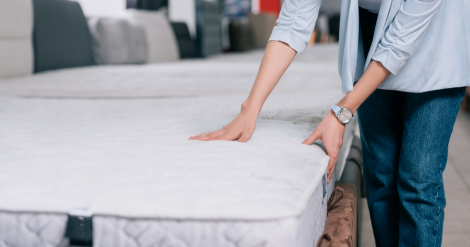No products in the cart.

Therapeutic Support Surfaces in Pediatric Units
Even though pressure injuries are most common in adult care units, there is an emerging awareness that acutely ill and immobilized children are also at risk. With relevant knowledge, however, clinicians can help prevent skin breakdown in pediatric settings. This article will describe risk factors for pediatric pressure ulcers and how therapeutic support surfaces can help prevent the development of decubitus ulcers in children. Therapeutic support surfaces in pediatric units are essential.
Intrinsic Risk Factors
As in adults, many factors contribute to skin breakdown and pressure injuries in pediatric patients. These include immobility, poor nutritional status, decreased sensory perception, and maceration. Children with spinal cord injuries are at very high risk because of their inability to feel pain. They are unable to sense when skin and underlying tissues are being traumatized from excessive pressure and poor perfusion. In addition, their bodies often have difficulty with temperature regulation. Hypothermia increases the risk of skin breakdown due to peripheral vasoconstriction while the mechanical strength of the skin is reduced by hyperthermia (1,2,3). Involuntary muscle spasms can also cause damage to the skin from friction and shearing. Finally, chronic fecal and/or urinary incontinence is strongly associated with skin breakdown (1,2,4).
Medical Devices & Treatments
Pediatric critical care units have the highest incidence of pressure injuries, particularly for children who are sedated and ventilated for long periods. Frequent repositioning is difficult due to physiologic instability as well as the presence of infusion and monitoring lines. Respiratory and airway devices are especially problematic, especially when endotracheal and tracheostomy tubes must be secured. High Frequency Oscillatory Ventilation (HFOV) also exposes the skin to prolonged shear and friction. Overall, more than half of pressure ulcers in critically ill children can be attributed to the medical devices that are used for their care (2,5,6,12).
Assessment
Standardized skin assessment tools are the first step in the prevention of pressure injuries. The Braden Q Scale is the pediatric version of the widely used Braden Scale for adults. It contains the original six Braden subscales along with a seventh for tissue oxygenation and perfusion. The Braden Q Scale is recommended for use with children from 21 days to 8 years of age (2,3,5,7,8). The Glamorgan Scale was the first pediatric pressure risk assessment scale to be developed using patient data analysis. It is also the first widely used assessment scale to include medical devices as a risk factor. The sensitivity, specificity and predictive validity of the Glamorgan Scale was found to be greater than the Braden Q Scale (8,9).
Pressure Injury Prevention
Upgrading standard hospital bed mattresses to pressure redistribution foam mattresses, especially for pediatric critical care units and children with spinal cord injuries. They do not eliminate the need for frequent repositioning but the interface pressure between the skin and mattress is significantly lower. Viscoelastic multilayered surfaces with convoluted foam are preferred as most low air loss beds cannot accommodate the height and weight of small children. This is because their feet, elbows, and buttocks often sink into and between the cushions of the mattress (2,5,10,11). A low-friction interface is also required to reduce shear injuries from HFOV, muscle spasms and repositioning.
Pediatric Sized Therapeutic Support Surfaces
MedMattress offers a variety of Crib and Child Mattresses to fit pediatric hospital beds, cribs, incubators and infant warmers. They have three layers of CertiPUR-US® multi-density foam to offer comfort and support for even the smallest patients. The soft conforming foam top layers cradle the patient’s body and allows airflow to trap less body heat. The higher density foam base provides foundational support and pressure redistribution. All MedMattress pediatric mattress covers have ultrasonically sealed seams and a waterproof vent system to protect the foam core from moisture. The medical grade, low-shear nylon top cover is fluid resistant, antibacterial, stain resistant, and latex free. The secondary fluid barrier ensures that the foam core remains dry even if the outer cover is compromised. A built-in fire barrier adds an extra layer of protection against flame.
Support surfaces for Children in Full-Size Hospital Beds
For children in full-sized hospital beds, MedMattress Care Mattresses are a budget conscious alternative to alternating pressure mattresses. They are made from CertiPUR-US® foam to offer pressure redistribution for patients at low, medium, and high risk of skin breakdown. As shown below, the dual-layered Care and Care Plus mattresses are appropriate for children who are considered to be at low risk for skin breakdown. The dual-layered Pro Care mattress provides additional protection for moderate to high risk patients in critical care areas. Finally, the tri-layered Advanced and Ultra Care mattresses offer maximum pressure redistribution, postural support and heat dissipation for high-risk patients. Care mattresses have the same high quality covers as the pediatric mattresses but with a 360° zipper for easy inspection of the core.
Key Takeaway
Even though most pressure injury prevention is focused on adults, children are still at risk for painful skin breakdown. Serious illness, neurologic dysfunction and immobility are primary risk factors that must be taken into consideration when caring for pediatric patients. The MedMattress team is ready to help pediatric clinicians balance cost and functionality while protecting their patients from pressure injuries.
References
- McCaskey, M., Kirk, L. & Gerdes, C. (2011). Preventing skin breakdown in the immobile child in the home care setting. Home Healthcare Nurse, 29(4), 248-55.
- Baharestani, M. & Ratliff, C. (2007) Pressure ulcers in neonates and children: An NPUAP white paper. Advances in Skin & Wound Care, 20(4), 208, 210, 212, 214, 216, 218-20.
- Sarsak, H. (2018). Review of pressure ulcers management in pediatrics: Assessment, prevention, and intervention. Journal of Pediatrics & Neonatal Care, 8(5), 245-248.
- Atiyeh, B. & Hayek, S. (2005). Pressure sores with associated spasticity: A clinical challenge. International Wound Journal, 2(1), 77-80.
- Delmore, D., Deppisch, M., Sylvia, C., Luna-Anderson, C. & Nie, A.(2019). Pressure injuries in the pediatric population: A National Pressure Ulcer Advisory Panel white paper. Advances in Skin & Wound Care, 32(9), E1.
- Agency for Healthcare Research and Quality. (2016). Pressure ulcers in the pediatric patient: Selected Best Practices and Suggestions for Improvement. Retrieved from https://www.ahrq.gov/sites/default/files/wysiwyg/professionals/systems/hospital/qitoolkit/combined/d4p_combo_pdi02-pressureulcer-bestpractices.pdf
- Chun, X., Lin, Y., Ma, J., … Yang, H. (2019). Predictive efficacy of the Braden Q Scale for pediatric pressure ulcer risk assessment in the PICU: A meta-analysis. Pediatric Research, 86(4), 436-443.
- Anthony, D., Willock, J., & Baharestani, M. (2010). A comparison of Braden Q, Garvin and Glamorgan risk assessment scales in paediatrics. Journal of Tissue Viability, 19, 98-105.
- Willock, J., Baharestani, M., & Anthony, D. (2009). The development of the Glamorgan paediatric pressure ulcer risk assessment scale. Journal of Wound Care, 18(1), 17-21.
- Reyna, R. (2015). Preventing pressure ulcers in pediatric patients. Wound Care Advisor, 5(5). Retrieved from https://woundcareadvisor.com/preventing-pressure-ulcers-in-pediatric-patients_vol4-no4/
- Razmus, I. & Bergquist-Beringer, S. (2017). Pressure ulcer risk and prevention practices in pediatric patients: A secondary analysis of data from the National Database of Nursing Quality Indicators. Ostomy Wound Management. 63(2), 28-32.
Tawhara, G. & Forster, E. (2021). Paediatric pressure injury prevention strategies: A review. Journal of Children and Young People’s Health, 2(1), 10-18.
You might also be interested in:

-
/
Rest for Success: When to Bid Adieu to Your Old Mattress
Rest for Success: When to Bid Adieu to Your Old Mattress We spend about a third of our lives in bed, and the quality of our sleep directly impacts our overall well-being. One often overlooked factor in achieving a good night’s sleep is the condition of our mattress. As the years go by, our faithful […]
Read more
Unveiling the Truth: Busting Common Mattress Myths
Unveiling the Truth: Busting Common Mattress Myths A good night’s sleep is crucial for overall well-being, and the right mattress plays a pivotal role in achieving that. However, amidst the quest for the perfect mattress, numerous misconceptions have caused mattress shoppers confusion when searching for the right mattress. Our latest blog unravels the truth behind […]
Read more
-
/
How Medical Bed Mattresses Aid in Post-Surgery Recovery
How Medical Bed Mattresses Aid in Post-Surgery Recovery Surgery can be a daunting experience, regardless of its nature or severity. The period following a surgical procedure, known as post-surgery recovery, is crucial for achieving the best possible outcome. While factors like rest, nutrition and pain management are widely acknowledged as vital, the role that medical […]
Read more
-
/
Meeting Medical Mattress Quality Standards
Meeting Medical Mattress Quality Standards Medical mattresses are designed to meet specific quality standards to ensure patient safety, comfort and hygiene. These standards are established to address the unique needs of healthcare environments as well as the patients utilizing these mattresses. Some key quality standards for medical mattresses include: Infection Control Standards Water […]
Read more
